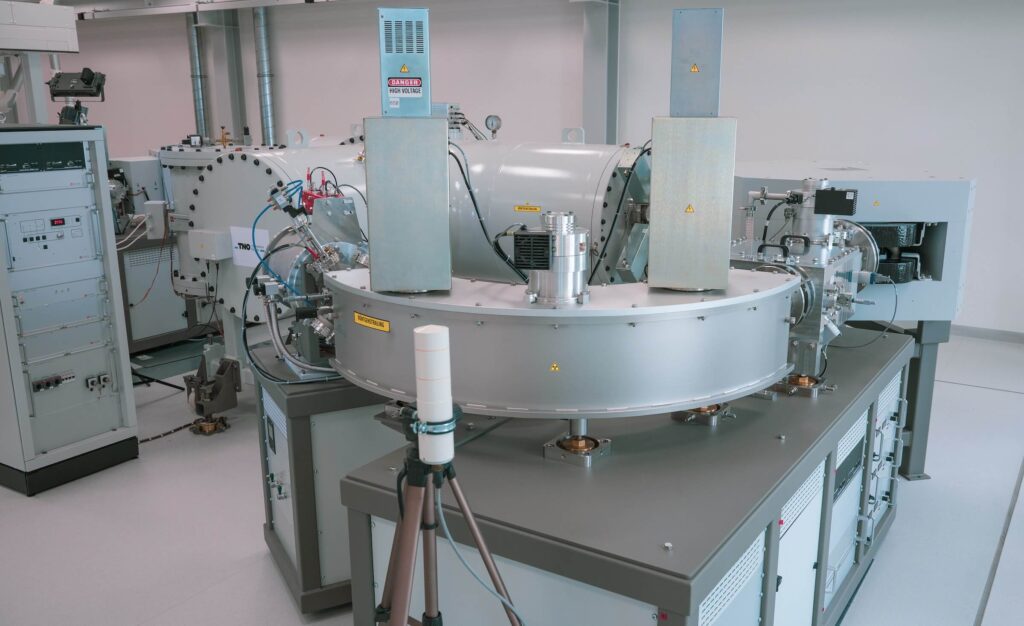Technology in short
- Disrupt traditional drug development
- A microtracer approach as a game changer
- Enrichment of data package at an early stage and the elimination of the need of animals, time and money spending on non-relevant animal metabolites.
Peregrion operates, within their laboratories, three Biomedical Accelerator Mass spectrometry systems. All AMS systems are equipped with proprietary sample preparation devices that enable rapid turnaround of clinical samples from 14C-microtracer human mass balance and/or absolute bioavailability studies. The exquisite sensitivity of the AMS analysis, in combination with data rich high-resolution mass spectrometry, enable full metabolite profiling and identification already in early clinical development for new candidate drugs. We deliver data to our clients to support their submission to regulatory agencies with regulatory required or requested data such as human metabolism, routes of excretion, absolute bioavailability, and fraction absorbed. Moreover, the earlier availability of data, from these AMS enabled microtracer studies, provides your ADME, Pharmacometrics, PBPK and formulation scientists with essential data to fine tune dosing regimes and formulation development to optimize further clinical development.

Why? Earlier availability of important human data eliminates the need of de-risking your pipeline with costly, labor intensive and time consuming animal radiolabeled ADME studies. ADME: Human first, human only!
Background of the AMS enabled hADME Paradigm shift

To obtain marketing authorization for new drug entities, regulatory agencies worldwide require biopharmaceutical companies to supply sufficient safety and efficacy data. To enable a complete safety and efficacy assessment, it is primordial to know to what extent patients are exposed to the drug itself but also to drug derived metabolites. For, every metabolite might have toxicological or pharmacological implications by itself. Therefore, only at the moment that we know that all metabolites are accounted for in humans, in terms of identity, exposure levels and elimination from the body, an assessment can be made whether these metabolites are also present those animals that were used for safety and efficacy assessments. Consequently, only then, we can assess whether the exposure can sufficiently guarantee long term safety for patients.
Clearly, the only methodology to ascertain that all metabolites will be found, is by incorporating radioactivity in the drug molecule to be able to trace all drug related material in the systemic circulation. Since virtually all drugs contain carbon, the highest scientific standard practice is to synthesize the drug with incorporation of radioactive carbon-14, and to dose this radioactive material to a small number of healthy volunteers or patients in a so called hADME study (human Absorption, Distribution, Metabolism and Excretion). Samples from excreta and blood or plasma can then be analyzed to trace the drug and all of its metabolites.
What is the common practice?
Classical methodology to measure radioactivity in such biological samples, i.e., Liquid Scintillation Counting (LSC), is not very sensitive, and as a consequence, the radioactive dose to enable such a hADME study needs to be rather high. Radiation Protection agencies worldwide would find such a study only ethical if the drug has a good chance to finally obtain the marketing authorization and therefore these studies are classified by the International Committee on Radiation Protection (ICRP) as Class II studies (ethically justified if the study acquires knowledge and the study improves health). Logically, the classical hADME study is conducted in late stage clinical development. One has to realize that the uncertainty that this late stage human data availability brings to the toxicological risk assessment is an attrition risk by itself. Therefore, it has become common practice in pharma industry to conduct animal studies with radioactive drug materials as a surrogate for human data, until these latter become available. This ‘animal-first, human later’ approach leads to the perception that risks due to metabolism are mitigated, but as we all know, data from animal studies are most certainly not always predictive for the human situation.
To summarize this in one sentence: The low sensitivity of LSC forced scientists to use animals at early stage for risk mitigation to only collect the truly required human data, years later.
What do we do different?
At Peregrion, we have developed a game changing technology that can repair this flaw in the current drug development process. Our automated sample combustion technology has enabled the practical use of Accelerator Mass Spectrometry AMS, a technology that is commonly in use for archeological dating, to the biopharmaceutical hADME study.
So, why is this game changing?
The sensitivity of our AMS system allows biopharmaceutical companies to conduct their hADME studies with at least hundred-fold less radioactivity. Therefore, these studies are commonly referred to as microtracer studies. Unlike conventional ICRP Radiation Class II studies, the microtracer approach would be classified as Class I study, which is considered to be ethically justified if the study acquires knowledge, the basic ethical requirement for any clinical study by itself.

Thus, the use of microtracer levels of radiolabeled drugs allows the conduct of ethical clinical trials at any point during clinical development:
- Phase 0-pharmacokinetic microdosing studies. ICH M3(R2) describes the possibility of human pharmacokinetic assessment of (multiple) candidate drugs at extremely low doses (<100 µg), even before phase 1 studies. Inconclusive animal studies or the availability of multiple drug candidates with similar in vitro tox/PD profiles can be a reason to conduct a microdosing study, often mostly directed to determine the half-life o the drug. This allows better predictions of the first dosing level and dosing intervals in your Phase 1 study, all based on human PK data. Some confusing literature data might suggest that dose-linearity in microdosing studies is often an issue. Nevertheless, a meta review from Van Nuland et al. in 2019 clearly shows that the predictivity to extrapolate to therapeutic doses from microdosing is good for oral drugs (68%) and even very good (94% predictivity) for intravenous drugs. In addition, we (Bosgra et al.) published an approach in 2016 to single out compounds with expected non-linear behavior.
- Phase 1 and 2-Intravenous microtracer absolute bioavailability studies. Although in only few countries absolute bioavailability is required, many regulatory agencies request information on the absolute bioavailability of orally dosed drugs. In addition, Pharmacometrics/(PB)PK scientists use models for dose predictions in which absolute bioavailability is a crucial parameter. Basically, there are three ways of conducting absolute bioavailability studies; the parallel group design (two groups single dose), the cross-over design (one group two dosing moments) or the IV-microtracer approach. In the latter approach, the IV dose is given as a microdose around tmax of the oral administration. The main advantage is that it concerns the same individuals for oral and IV administration, and thus the power per subject in the study is higher, which enables a small group size. In addition, only one group needs to be dosed in one interval. This study is often conducted as part of a two-arm study together with the mass-balance/metabolite profiling study. For the mass balance study design, 14C labeled material needs to be available, and therefore the same synthesized labeled material can be used, and only a specific microdose IV formulation needs to be developed, so the additional costs are limited.
- Phase 1 and 2-Oral microtracer mass balance/metabolite profiling study. The original Metabolites in Safety Testing guidance, which is nowadays with some modifications also part of ICH M3 (R2), requires that drug metabolites that are observed at concentrations of > 10% of the total drug related material, and that are significantly higher in humans than in animals or even unique to humans, should be nonclinically characterized. Therefore, mass balance studies are conducted to characterize the extent of human metabolism and the excretion routes. In a microtracer mass balance study, typically 1 µCi of the 14C-labeled drug is dosed orally at or around therapeutic level, and plasma and excreta are collected until >90% is excreted. The low 1 µCi radioactive dose does not require animal dosimetry studies. These studies will provide the routes, the rates and the quantity of drug and metabolites that are found in the excreta. More importantly, from a toxicological perspective, the plasma metabolite profile can be established where both the identity as the concentration of each metabolite is characterized using a combined UPLC-AMS-hrMS/MS approach. When all metabolites >10% of the drug related material are identified, supervised techniques like LC-MS/MS can be used to compare the systemic concentrations in humans with those in animals from the species that were used for the toxicological assessment.

What are combined advantages?
Overall, the combined two-arm IV microtracer and mass balance/metabolite profiling study in early clinical developments gives an enormous enrichment of the data package available at early stage. The data richness allows better study designs for follow up clinical studies, it allows earlier assessment and risk mitigation strategies for unexpected human unique metabolites, and it eliminates the need to conduct radioactive animal mass balance/metabolite profiling studies, where many animals, and much time and money are being spent on non-relevant animal metabolites.
